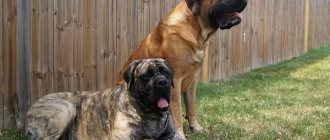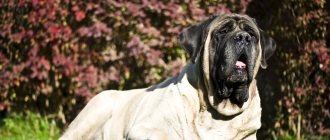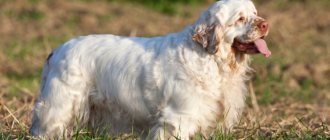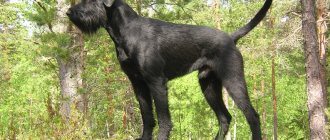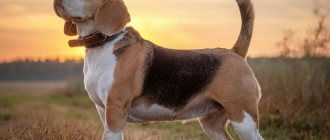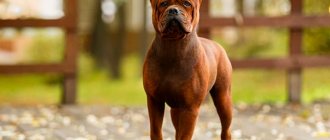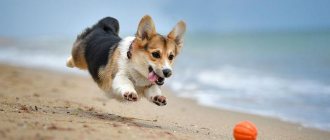Behind a very intimidating appearance hides a very noble, generous and not at all formidable dog. The Great Dane is an aristocrat and a true gentleman of the dog world. Another name for this breed is mastiff, which means horse-dog in the Basurman language. The name speaks for itself. Strong build, impressive size, kind and devoted look. You can be sure that such a pet will protect any family member and become everyone’s favorite and irreplaceable friend.
Origin of the breed
There is still no consensus on what breed of dog the English Great Dane came from. It is known that animals vaguely similar to the mastiff lived in Central Asia approximately 2000 BC.
There are also legends that dogs similar to the Great Dane were brought to the British Isles by Phoenician traders. After that they were bought by the Romans. They used the animals for hunting big game and for fighting. It is worth noting that the same people gave their pets the name “War Dog of the Britons.” The breed was then bred throughout Europe and crossed with other dogs from the islands.
Much later in England, a rather bloody form of entertainment began to gain popularity - baiting bulls and bears. The essence was that an angry dog descended on the chained animal, and a fight took place. Until the 15th century, the most popular breed for this “sport” was the English Great Dane. This was explained by the dog’s large size and rather aggressive character. However, during the same period, bulldogs were gaining popularity. Thus displacing mastiffs from this area. The new breed was much smaller and had greater agility, and also had a high pain threshold, which made fights more spectacular.
Nevertheless, the use of Great Danes in dog fighting and baiting continued until this entertainment was banned in 1835. After changes in laws and the abolition of events that required extremely aggressive animals, a change in the character of the English Great Dane occurred. The dogs became soft and lazy. Mixing of this breed with bulldogs of the Old English type began. The result was a breed called the Bullmastiff.
Somewhat earlier, around the 17th century, dog shows were gaining popularity in England. This served as the start for the formation of such concepts as pedigree, stud book and kennel club. The first official documentation of English Great Dane puppies appeared in 1800. At the same time, special clubs for this breed began to appear.
At this time, not only people from the upper classes, but also ordinary peasants began to own mastiffs. Nevertheless, keeping an animal was quite difficult and expensive. And due to the fact that it was easiest for the butchers, who could feed the English Great Dane scraps, the dog received the nickname “butcher’s dog.”
The First World War hit the animal population very hard. Moreover, the population reduction occurred in an extremely cruel way. By the owners themselves. The problem was that the English Great Dane consumed slightly more food than the soldiers fighting on the Western Front. Then many breeders and dog owners decided to euthanize the animals. As a result, by the end of the war the number of individuals decreased sharply.
The salvation for the breed was its arrival in America and Canada. Several individuals of Great Danes appeared there, which subsequently began to slowly increase their population on the continent. The final step towards the restoration of the breed was the creation in 1929 of the Mastiff Club of America, which began to increase the number of representatives.
A little later, after the outbreak of World War II, the breed was again under attack. In England, the number of individuals has decreased to a few heads. Almost all of them died from the disease. The last one left was the female. She was registered as an English Mastiff. However, it is suspected that her father was a bullmastiff.
There are only 14 individuals left in the United States. As a result, these 15 representatives turned out to be the progenitors of all modern Great Danes.
After the war, namely in 1948, the breed was officially recognized by the English club UKC. However, there is still an opinion that when restoring the population, bullmastiffs were also used, which could violate the purity of the blood.
Today, the population's income allows them to keep dogs of this breed. However, due to their soft character, they ceased to be watchdogs. Now the mastiff is a fairly kind companion dog, which at the same time is capable of protecting its owner.
Next will be the characteristic features of dogs of the English Great Dane breed and photos for demonstration.
How and what to feed your Great Dane
Professional breeders are of the opinion that commercial feed is the best option. Their belief is related to a balanced diet, a sufficient amount of vitamins and minerals. Ordinary lovers are opponents of this approach and choose natural nutrition. In any case, mixing the two types of food is strictly prohibited.
Rules for natural nutrition:
- food is always prepared immediately before serving to the pet; it should be at room temperature;
- the bowl should always be filled with clean drinking water;
- table leftovers are strictly prohibited;
- If the pet has not eaten what was offered within 20 minutes, then the excess is put into the refrigerator and left until the next feeding.
Important! It is better not to feed your pet before walking.
The list of permitted products is presented:
- raw or scalded meat with boiling water - chicken, rabbit, beef, turkey;
- raw, stewed and baked vegetables;
- fruits and herbs;
- buckwheat, oatmeal, rice porridge;
- one chicken egg per week;
- offal;
- fermented milk products - low-fat cottage cheese, yogurt, kefir.
The category of prohibited products is represented by:
- fatty meat - lamb, pork;
- chocolate and confectionery products;
- smoked, salty, spicy dishes;
- legumes, pasta;
- river fish.
Important! When feeding industrial or natural products, it is necessary to monitor the condition of the pet. Some may cause allergic reactions.
Breed standard
This is quite a big dog. Her physique is proportional, the minimum height is 70 centimeters at the withers, and her weight reaches 87 kilograms. By the way, there is one small confusion here. Because the English Mastiff is often called a Great Dane, many people expect to see a dog similar to the Great Dane.
How much does a puppy cost?
The average cost of an English mastiff varies from 30,000 to 60,000 rubles. Depends on the purebred of the puppy and the titles of the parents.
The price is influenced by the gender of the dog, compliance with standards and the location of the kennel. A lower price most likely means it does not meet the standard of the English Great Dane breed.
However, you shouldn’t give up purchasing such a puppy right away. If the animal is completely healthy, and standard data is not so important for the future owner, it is worth buying a small English Dane.
Let your pet not become a champion of exhibitions and shows. But for the owner and his family, the dog will definitely be a friendly companion and an ideal friend who will be able to brighten up everyday life with warm, tight hugs!
Character
The Great Dane is a very large and intimidating dog, but at the same time with a wonderful character. During selection, temperament was softened and cruelty and aggressiveness towards strangers was eliminated.
At the moment, the distinctive features in the behavior of this animal are:
- Equilibrium.
- Calm.
- Nobility.
The dog is quite silent and does not voice over trifles.
It is worth noting that, despite all its massiveness, the English Great Dane is extremely active and mobile. While running, he can reach quite impressive speeds. External phlegmatism disappears when the dog turns out to be very interested in something and behaves like a curious puppy.
He will prefer to spend most of the day on the couch.
As a watchdog, the mastiff is quite calm. He won't attack a stranger. But at the same time, he will not allow him to enter his territory without the owner’s permission.
The English Great Dane gets along well with children. Able to endure fuss and pranks for a long time. As soon as patience runs out, he simply moves away from the source of irritation.
Owner reviews
Vera, 39 years old: “I got this faithful and affectionate creature 2 years ago. The most amazing thing is that he seems to understand our speech! I would never have thought that these giants could be so kind and understanding.”
Oleg, 34 years old: “I had a long-lived Great Dane: he lived for 9 years, although the average lifespan for them is about 7. I remember how he joyfully greeted me from work, and as he saw me off, he looked pitifully, almost shedding tears. An exceptionally sensitive dog."
Anna, 23 years old: “A very smart breed and non-aggressive, as many people think. The main thing is to educate correctly, then there will be no problems.”
Pet care
The English Great Dane has a fairly short coat that does not require frequent bathing. Just regular brushing.
Particular and constant attention should be paid to wrinkles on the pet's face. They need to be cleaned after every meal. Otherwise, accumulated moisture, dirt and dust may lead to infection.
The mastiff needs to be fed 2 times a day. To avoid volvulus.
It is important to note that the latter is one of the main health problems for dogs with this chest structure. In the absence of timely surgical intervention, the dog will quickly die.
Who Shouldn't Own a Great Dane
Breeders recommend listening to the following advice:
- Living in small apartments is not suitable for giant dogs. The pet should have its own place to sleep and rest, and move freely. For the northern regions, animals can be kept in large areas of the home; for the southern regions, it is necessary to build a well-maintained enclosure on a personal plot;
- Busy people should not have such pets; the Blue Great Dane must undergo compulsory training. A well-mannered dog needs long walks of at least an hour every day;
- a person with a vulnerable psyche must remember that Great Danes live for a short time, and their death will cause serious stress.
Note! Don't forget about the cost of feeding large dogs. People with limited financial means are not able to provide normal nutrition, regular consultations with veterinarians and the necessary little things (timely replacement of bedding, bowls, toys, ammunition)
Results
By listing all the main thoughts from this article, the following theses can be formed:
- This breed is excellent for guarding territory, but is extremely silent.
- Has a highly developed defender mechanism. But without proper upbringing, he can show aggression towards others.
- Young individuals must undergo special training. This is explained by the fact that managing such a large dog is quite difficult.
- The dog is quite lazy and prone to gaining excess weight. Daily walks help solve the problem.
- Not suitable for living on a chain. An animal separated from its household becomes depressed.
- It is necessary to buy a puppy only from trusted and well-known nurseries. Of course, this can be quite expensive. But a professional breeder will help you understand all the intricacies of keeping an English Dane.
- Adults are excellent companions. They are calmer, quieter and more manageable.
- Sufficiently short fur sheds heavily.
- It gets along well in an apartment or private house with a small yard. But in this case, you need to walk the dog at least 3 hours a day.
- The animal gets along well with children and the elderly. At the same time, it is quite bulky and can accidentally drop or knock over a child or an elderly person.
- Has increased salivation. But significantly less than other breeds with a similar jaw structure.
- When walking an animal, it is necessary to avoid overheating. It can lead to the death of the dog.
- And yes. The English Mastiff snores extremely loudly.
Bordeaux (French Mastiff)
Two regions fought for this breed in France - Paris and Bordeaux. For some time, Great Danes were divided by color - those with a black mask belonged to the center and were called Parisian, those with a red mask belonged to the west, and were called Bordeaux. But over time, the individuals were united by one standard.
Dogs have been mentioned in chronicles since the 15th century. These animals served as livestock guards, property protectors, and workers in butcher shops, pulling carts. Bordeaux were registered in 1926.
Outwardly, Dog is an absolutely calm dog, lazy and kind . He actually is like that until it comes to protecting the house. The attacker will be in a difficult position if he angers Bordeaux or covets the owner's property.
The breed is large and heavy with the characteristic characteristics of a mastiff. Their typical height is 60-68 cm, weight is 45-50 kg . Dogs have a large head and a thick neck, a muscular elongated body, and short limbs. The square shape of the muzzle provides a strong grip, for which the dogs were valued by the organizers of dog fights. A distinctive feature is the upturned nose.
Bordeaux's coat The muzzle is carefully covered with folds. The standard color is red or red in all variations; a mask is allowed.
The dogs are energetic, strong and resilient. They are devoted to their owner and their work, they love their family. Calm in everyday life. But when it comes to defending property, they are relentless, brave and ferocious. Like other Great Danes, Bordeaux require special attention, training and increased intensity physical activity.
The breed can get along in an apartment with enough walking, but the pet will feel better outside the city, in the wild, where it does not need to wear a muzzle and walk on a leash. The average cost of a puppy is 25,000 rubles.
Description
English Mastiff photo and description
English Mastiffs are huge dogs, better known as “gentle giants”. They are intelligent and calm in nature. Dogs prefer to be in a home environment and be involved in everything that happens around them.
— Advertising —
These are dogs with large square heads. They have a majestic look, a wide skull and a flat forehead with wrinkles. Individuals have well-developed cheeks. English Mastiffs have short muzzles, wide noses, and well-opened nostrils. Their lips are slightly downturned, their eyes are widely spaced, moderately large, and dark brown in color. The ears of the species are small, thin, located close to the cheeks in a relaxed state. Dogs have a strong jaw and powerful teeth.
Photo of English Mastiff dog
They have moderately long, slightly arched necks, as well as muscular, sloping shoulders. The front legs are strong and straight. The chest is wide, the ribs are rounded and curved. The back, lower back, and hind limbs of the animals are muscular and wide. The paws are round, large, with convex toes and black nails. The English Mastiff has a high-set tail that is wider at the base and tapers towards the tip. When excited, the tail is directed upward, but not above the level of the back.
Mating
Typically, girls of this breed come into heat before the age of 1 year. However, this is not a suitable age for mating, since if she becomes pregnant, she simply will not be able to bear healthy offspring. You need to wait 2-3 heats to make sure that the animal’s body is working normally.
Mastiff males are allowed to mate from 12 months
It is important to consider the size of the dog. Small animals are allowed to breed earlier
It is important to track the period of sexual heat of the animal. This is the best time for mating
To know when is the best time to breed an animal, it is best to consult an expert because each dog has its own characteristics. If you are not sure that everything will go well, it is better to invite a specialist for the first time. It will help prevent possible difficulties.
The main thing is that before mating the animal is well-fed and has a good walk.
A dog's pregnancy lasts from 60 to 70 days. Childbirth is usually quite difficult. On average, a female dog can give birth to up to 5 puppies.
Features of training
Due to their large size, Great Danes often act as guards. But it is not worth training them according to the program for fighters; it will not be possible to develop aggression in a dog. Great Dane training should follow a general program.
It provides training in general commands (sit, lie down, place, voice, fetch), helps to get used to wearing a collar and muzzle, and walking on a leash. Dog handlers also teach dogs to behave calmly during examination by a veterinarian and not to be scared by loud, sharp sounds or a gunshot.
This breed is distinguished by good intelligence, so most often there are no problems with training. It is recommended to start training sessions at the age of two months.
For correct completion of the task, you can feed the Great Dane with a treat. This way, the dog will be more interested in learning. Provided proper and timely upbringing, this large pet will be easy to manage and there will be no problems with adaptation to society.
Possible diseases and methods of treating them
Large dogs often suffer from the rapid development of hip dysplasia. Sick animals cannot walk smoothly and often have severe pain in the leg area. How can I help them? Usually, the discomfort associated with dysplasia is relieved with painkillers. They are prescribed by a veterinarian. It is this specialist who prescribes treatment in each specific case.
And some Great Danes periodically experience food allergies. The reason is the frequent consumption of sweets with fatty foods. To avoid the risk of adverse reactions in your pets, give them dry food twice a day.
Education
It is better to start training individuals as early as possible. It must be consistent and always fair. It is important for dogs to understand what is expected of them. Babies need to be taught the "basics" as soon as they arrive in their new homes.
English Mastiff in the grass photo
Training should be short and interesting so that the animal is focused on what is required of it. With long and repeated training, it is difficult to keep the dogs' attention. Being sensitive by nature, Mastiffs do not respond well to any harsh corrections or more "heavy" methods. Pets will be happy to be rewarded for their work in the form of treats.
All puppies should be provided with limits and boundaries. The first commands that kids need to be taught are:
- Come
- Sit
- Stay
- Quiet
- leave it
- Down
- Bed.
Interesting Facts
You can tell quite a lot of interesting things about this breed:
- The Dogue de Bordeaux is considered one of the oldest French breeds.
- Nowadays the correct name is Dogue de Bordeaux (with one “s”). The double "s" (Bordeaux) comes from the old French spelling. It is not forbidden to use it.
- During World War II, dogs of this breed were on the verge of extinction. In the 50s, active measures were taken to restore the population.
- One of the most famous representatives of the breed is the dog who played the partner of detective Scott Turner (Tom Hanks) in the film Turner and Hooch.
- The breed has many names - French Mastiff, Dogue de Bordeaux, Dogue de Aquitaine, Bordeaux Shepherd, Dogue Maltese. However, it should not be confused with the Maltese (Maltese) - this is a completely different decorative breed.
- The Dogue de Bordeaux is a brachycephalic dog. Due to the structure of its muzzle, it cannot be transported on an airplane - the dog could suffocate.

